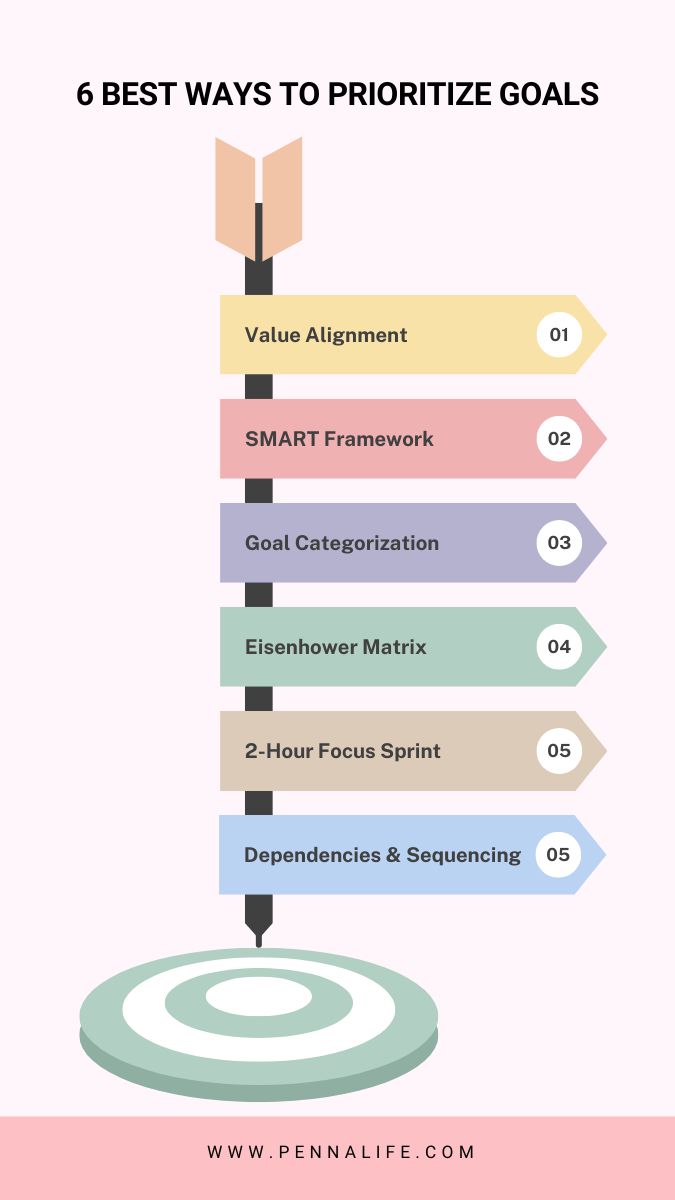If you’re wondering, “What is the most important step in prioritizing goals?” This productivity guide is for you.

Do you find yourself staring at a to-do list that seems to stretch into infinity?
Three work projects with competing deadlines, that online course you’d paid for but haven’t started, and the half-finished home renovation project taunting you every time you walk through the door.
If nothing seems to be moving forward despite being busy all day, grab a seat and note the serious revelation I’m about to share with you.
As humans with numerous responsibilities, we jump from one “important” matter to another, leaving a trail of half-finished projects in our wake.
The problem isn’t a lack of work ethic. It’s a lack of proper prioritization, but not in the way that you think.
In this guide, I’m going to share what I’ve discovered to be the most important step in prioritizing goals and how this discovery helped me organize my overwhelming tasks, life plans, and projects in only seven days.
What Is Goal Prioritization?
Goal prioritization is the process of evaluating and ranking your goals based on specific criteria to determine which ones deserve your immediate attention and resources.
It’s about deciding what to focus on first.
Now, why does this matter?
The statistics speak for themselves. A Harvard Business Review study found that the average person who doesn’t prioritize spends 41% of their time on tasks that could be handled another way or eliminated entirely.
The goal prioritization process typically involves several steps:
- Listing all your goals
- Evaluating them against values and other criteria
- Ranking them in order of importance
- Allocating resources accordingly
- Regularly reviewing and adjusting as needed
But within this process, one step stands above all others.
The Most Important Step in Goal Prioritization: Value Alignment
A while ago, I shared a case study on how I organized my life goals in only seven days.
And as crazy as it sounds, it happened—and it’s because I discovered the single most important step in prioritizing goals.
Aligning them with your core personal or organizational values.
This might sound obvious, but it’s astonishing how often we pursue goals that have little connection to what we truly care about.
We chase promotions we don’t actually want, pursue hobbies that don’t genuinely interest us, or adopt others’ definitions of success rather than defining our own.
When goals don’t align with your values or interests, you start to stall.
But the reality is that each postponed task doesn’t disappear. It lingers, creating mental clutter, and eventually spawning additional tasks as deadlines loom closer.
Before you know it, you’re buried under an avalanche of to-dos that you can’t seem to motivate yourself to tackle. This is how misaligned goals lead to overwhelming task buildup.
So, why does value alignment trump all other prioritization methods?
Because without it, even the most efficiently executed goal can leave you feeling empty or frustrated.
If you’ve ever accomplished something you thought you wanted, only to feel strangely unfulfilled afterward, that’s the telltale sign of a goal that wasn’t aligned with your true values.
Other Essential Goal Prioritization Processes
While value alignment is the critical foundation, several other important steps help complete an effective prioritization system:

Using the SMART Framework
This system ensures your goals are Specific, Measurable, Achievable, Relevant, and Time-bound.
This clarity makes evaluation and execution much easier.
For instance, “get healthier” becomes “walk 30 minutes three times weekly for the next three months.”
Categorizing Goals as Short- or Long-Term
Grouping goals this way helps you maintain perspective.
Short-term goals—that you target to achieve within the next 3 months—give you quick wins and momentum.
Whereas long-term goals—usually more than 6 months to several years—provide direction and purpose.
Applying the Eisenhower Matrix
The Eisenhower Matrix productivity method helps distinguish between urgent and important tasks.
This classic tool divides your goals into four categories:
- Important and urgent (do immediately)
- Important but not urgent (schedule time for these)
- Urgent but not important (delegate if possible)
- Neither urgent nor important (eliminate)
The 2-Hour Focus Sprint
This 2-hour productivity strategy is how I get more work done within only two hours than most people do in an entire day.
It involves preparing in advance for your daily tasks, setting the environment to motivate you, and timing yourself for a two-hour period to work without any distractions.
Identifying Dependencies & Sequencing
This means recognizing when one goal must precede another, like the strategy called habit stacking from the book Atomic Habits.
Some goals create a foundation for others, and tackling them in the right order increases your chances of success.
However, all these techniques fail without proper value alignment as the plan. They’re like navigational tools that are useless if you don’t know your destination.
How to Identify Your Core Values for Goal Alignment
Here’s a step-by-step process to identify your core values so you can align your goals with them.
1. Reflection
Set aside 30-60 minutes of uninterrupted time to think about moments when you felt most proud, content, fulfilled, or in flow.
What values were you honoring in those moments? What things were top of your mind during those times?
2. Value Inventory
Sometimes, you might not be able to come up with ideas off the top of your head.
You can search the term value inventory online or download this list of values by Brené Brown. There, you’ll get ideas on some value inspiration.
Your values can be anything. It can be integrity, adventure, family, learning, or wealth. And don’t feel guilty about your choices.
3. Clustering & Choosing
You might end up with a handful of values that matter. But it’s important to narrow them down to 3-5 core ones.
If you have too many, you’ll dilute your focus. Choose the ones that feel most essential to you.
You can also group similar values together and look for patterns.
For example, “learning,” “curiosity,” and “growth” might cluster as related values, and you might just choose “learning” to represent them.
4. Value-Mapping Exercise
List your top 5-10 current goals on one side of a page and your 3-5 core values on the other.
Draw lines connecting each goal to any values it serves.
When assessing whether a goal aligns with your values, ask yourself:
- Does pursuing this goal allow me to express my core values?
- Will achieving this goal bring me closer to living in alignment with what matters most to me?
- If I had to explain to someone I respect why this goal matters, could I connect it to my values?
- Does this goal feel energizing rather than draining?
Goals with multiple connections to core values likely deserve higher priority. Goals with no connections might need realignment or reconsideration.
The All-in-One Life Planner for Prioritizing Your Goals
Speaking of practical tools for goal prioritization, this is exactly why I created the All-in-One Life Planner. This digital planner is designed to help you align your daily actions with your life goals and values.

organize your life
The All-in-One Life Planner
A simple spreadsheet resource to plan, organize, and track your life goals in one place.
FAQs About Goal Prioritization
What is the most important step in prioritizing goals?
The most important step is aligning your goals with your core values. When goals connect to what truly matters to you, you’re more likely to follow through, even when challenges arise. Value alignment provides the “why” behind your prioritization decisions.
How do you prioritize multiple important goals?
Start by ensuring all goals have clear value alignment. Then assess urgency, dependencies, and resource requirements. Finally, try sequencing related goals to create momentum.
What tools can help me prioritize my goals effectively?
Beyond the All-in-One Life Planner, other effective tools include the Eisenhower Matrix method and value-mapping worksheets
How do I know if I’m prioritizing the right goals?
You’re prioritizing correctly when you (1.) are making consistent progress (rather than procrastinating) and (2.) can clearly explain how your goals connect to your core values.
What’s the difference between prioritizing and planning goals?
Prioritizing determines WHICH goals deserve your attention first. Planning determines HOW you’ll accomplish those goals, including the specific steps, timeline, and resources needed. Effective prioritization should always precede detailed planning.
In Summary: The Most Important Step In Prioritizing Goals
So, what is the most important step in prioritizing goals?
Value alignment, every time. It’s the fundamental foundation that makes all other prioritization techniques meaningful.
Take some time this week to revisit your current goals through the lens of your core values. You might be surprised to discover that some goals that have been consuming your energy don’t actually deserve such high priority.
Looking for more productivity techniques and tips to get more done?
Love this post? Share it with friends and/or bookmark it for later.








